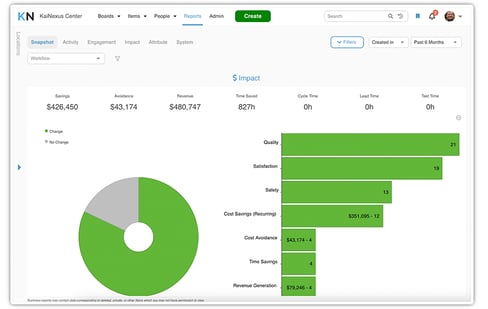Tracking the impact of a continuous improvement program is one of the most difficult challenges that an incoming consultant may face. As difficult as tracking impact is, it is also one of the most important metrics to measure. Organization leaders want to see a return on their investment of a consultant, and being able to capture the results of the improvement program is the easiest way to do so.
Most consultants capture the impact of improvement using spreadsheets or Sharepoint - if they are even able to capture impact at all.
There are a couple issues with this.
- Using spreadsheet impact data to track impact quickly means that ROI gets out of date because logging the impact is "optional”.
- Improvements can be marked as complete without having an impact logged.
- Sometimes improvements aren’t completed, and there are no active notifications as reminders. Using Continuous improvement software to track your impact means that all of the data is actually captured and notifications are sent out as reminders so that no improvements fall through the cracks.
Listen to this Post or Subscribe to the Podcast:
 Another benefit of continuous improvement software is it standardizes the process of logging impact so that every improvement is included. Combining spreadsheets and Sharepoint sites to aggregate impact is time-consuming and difficult. Forgetting to update a spreadsheet or to include it in calculations is entirely possible, an oversite which can easily have adverse effects on the impact that a consultant wants to show off. Using custom improvement software, on the other hand, means that all work is done on the same platform with the same set of improvement templates, workflows, and processes. This includes standardizing the process of always filling out the impact of the improvement.
Another benefit of continuous improvement software is it standardizes the process of logging impact so that every improvement is included. Combining spreadsheets and Sharepoint sites to aggregate impact is time-consuming and difficult. Forgetting to update a spreadsheet or to include it in calculations is entirely possible, an oversite which can easily have adverse effects on the impact that a consultant wants to show off. Using custom improvement software, on the other hand, means that all work is done on the same platform with the same set of improvement templates, workflows, and processes. This includes standardizing the process of always filling out the impact of the improvement.
Standardizing the impact recognition process also ensures that your ROI numbers are thorough and accurate. Continuous Improvement software's ROI tracking can track everything from hours saved to revenue generated, even drilling down into the details to show the impact of improvement on specific processes or products in an organization and calculate how much money is saved by using fewer resources. Do your improvements have an environmental impact? No worries, continuous improvement software can track that too.
The biggest benefit of using continuous improvement software is the ability to trace impact directly back to your consulting work.
Using the end-to-end reporting functions, you can track the financial impact of the improvement work and measure the engagement levels of staff members. Bringing these numbers to senior leadership in the organization shows exactly what change has been made since your consulting engagement began. Having this data at your disposal can be the difference-maker in renewing your consulting contract with the organizations you serve.



Add a Comment